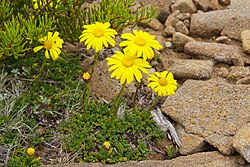Biology:Scapisenecio pectinatus
| Scapisenecio pectinatus | |
|---|---|

| |
| In Walls of Jerusalem National Park, Tasmania | |
| Scientific classification | |
| Kingdom: | Plantae |
| Clade: | Tracheophytes |
| Clade: | Angiosperms |
| Clade: | Eudicots |
| Clade: | Asterids |
| Order: | Asterales |
| Family: | Asteraceae |
| Genus: | Scapisenecio |
| Species: | S. pectinatus
|
| Binomial name | |
| Scapisenecio pectinatus (DC.) Schmidt-Leb.
| |
| Synonyms[1] | |
| |
Scapisenecio pectinatus, synonym Senecio pectinatus,[1] commonly known as alpine groundsel, is a species of flowering plant in the aster family.[2] The species occurs in alpine areas of south-eastern Australia in peat-based soils.[3][4] It has divided leaves forming a basal rosette and produces a single yellow flower head (up to 30 mm diameter) on a stalk up to 20 cm high.[3]
Taxonomy
The species was first described by Augustin Pyramus de Candolle in 1838 as Senecio pectinatus.[1] It was transferred to the new genus Scapisenecio in 2020 as a result of a molecular phylogenetic study of Australian species in the tribe Senecioneae.[5]
Two varieties are currently recognised:[1]
- Scapisenecio pectinatus var. major (F.Muell. ex Belcher) Schmidt-Leb. (Victoria and New South Wales)[6][7]
- Scapisenecio pectinatus var. pectinatus (Victoria and Tasmania)[6][8] It has small leaves with the tips of the divided segments curving inwards.[4]
A white-flowering variety, formerly Senecio pectinatus var. ochroleucus F.Muell., was promoted to species status in 2004 as Senecio albogilvus I.Thomps.,[9] and then transferred to Scapisenecio as Scapisenecio albogilvus.
References
- ↑ 1.0 1.1 1.2 1.3 "Scapisenecio pectinatus (DC.) Schmidt-Leb.". Plants of the World Online. Royal Botanic Gardens, Kew. http://www.plantsoftheworldonline.org/taxon/urn:lsid:ipni.org:names:77213369-1.
- ↑ "Senecio pectinatus DC.". Atlas of Living Australia. http://bie.ala.org.au/species/Senecio+pectinatus.
- ↑ 3.0 3.1 "Senecio pectinatus (DC.) Benth.". PlantNET - New South Wales Flora Online. Royal Botanic Gardens & Domain Trust, Sydney Australia. http://plantnet.rbgsyd.nsw.gov.au/cgi-bin/NSWfl.pl?page=nswfl&lvl=sp&name=Senecio~pectinatus=.
- ↑ 4.0 4.1 "Senecio pectinatus (Asteraceae)". Key to Tasmanian vascular plants. University of Tasmania. http://www.utas.edu.au/dicotkey/dicotkey/AST/ast/sSenecio_pectinatus.htm.
- ↑ Schmidt-Lebuhn, Alexander N.; Zeil-Rolfe, Isabel; Lepschi, Brendan; Gooden, Ben (2020). "Expansion of Lordhowea, and a new genus for scapose, alpine Australian species of Senecioneae (Asteraceae)". Taxon 69 (4): 756–777. doi:10.1002/tax.12321.
- ↑ 6.0 6.1 Walsh N.G and V. Stajsic. Census of the Vascular Plants of Victoria (Eighth ed.). Royal Botanic Gardens Melbourne. ISBN 978-0-9751362-8-7. http://www.rbg.vic.gov.au/viclist. Retrieved 10 January 2012.
- ↑ "Senecio pectinatus var. major F.Muell. ex Belcher". PlantNET - New South Wales Flora Online. Royal Botanic Gardens & Domain Trust, Sydney Australia. http://plantnet.rbgsyd.nsw.gov.au/cgi-bin/NSWfl.pl?page=nswfl&lvl=in&name=Senecio~pectinatus.
- ↑ "A Census of the vascular plants of Tasmania". http://www.tmag.tas.gov.au/__data/assets/pdf_file/0011/33041/Vascular_Plant_Census_2009_11.pdf.
- ↑ "Senecio pectinatus". Australian Plant Name Index (APNI), IBIS database. Centre for Plant Biodiversity Research, Australian Government, Canberra. http://www.anbg.gov.au/cgi-bin/apni?TAXON_NAME=Senecio+pectinatus.
Wikidata ☰ {{{from}}} entry
 |

